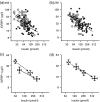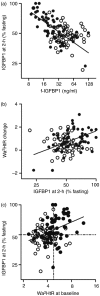IGF-binding protein 1 and abdominal obesity in the development of type 2 diabetes in women
- PMID: 20508082
- PMCID: PMC2909736
- DOI: 10.1530/EJE-10-0301
IGF-binding protein 1 and abdominal obesity in the development of type 2 diabetes in women
Abstract
Objective: Low levels of IGF-binding protein 1 (IGFBP1) are associated with metabolic syndrome and predict diabetes development in men. The aim of this study was to determine the levels of IGFBP1 in women who later develop diabetes, in relation to abdominal obesity, and to compare these levels with those of men.
Methods: IGFBP1 levels were determined at baseline and after 8 years in a case-control, prospective study of Swedish women aged 35-56 years. Individuals with normal oral glucose tolerance test (OGTT) who developed abnormal glucose regulation (n=240) were pair matched to controls for age and family history of diabetes and also compared to men of the same age (n=355).
Results: Low fasting IGFBP1 and increased waist measurement predicted development of diabetes in women (n=60; odds ratio (OR) 70, 95% confidence interval (CI) 8-661, lowest tertile and OR 27, 95% CI 5-141, highest tertile). In women developing diabetes, baseline IGFBP1 levels were lower than expected for fasting insulin values, were associated with impaired suppression after OGTT and increased during 8 years despite an increase in fasting insulin. All individuals in the highest tertile for waist and with <or=40% suppression of IGFBP1 developed diabetes within 8 years. Circulating IGFBP1 concentrations were higher in women compared to men. Women and men who developed diabetes had a similar degree of abdominal obesity, corrected for height.
Conclusions: We conclude that low IGFBP1 and elevated waist measurement predict diabetes development and that IGFBP1 production is suppressed by a novel factor(s) in women developing diabetes. Increasing levels of IGFBP1 during the emergence of diabetes in men and women suggest the emergence of hepatic insulin resistance.
Figures





Similar articles
-
Insulin-like growth factor-binding protein-1 in the prediction and development of type 2 diabetes in middle-aged Swedish men.Diabetologia. 2008 Jul;51(7):1135-45. doi: 10.1007/s00125-008-1016-x. Epub 2008 May 22. Diabetologia. 2008. PMID: 18496669
-
Low IGF1 and high IGFBP1 predict diabetes onset in prediabetic patients.Eur J Endocrinol. 2022 Sep 19;187(4):555-565. doi: 10.1530/EJE-22-0034. Print 2022 Oct 1. Eur J Endocrinol. 2022. PMID: 36005859
-
Contribution of Liver Fat to Weight Loss-Induced Changes in Serum Hepatokines: A Randomized Controlled Trial.J Clin Endocrinol Metab. 2019 Jul 1;104(7):2719-2727. doi: 10.1210/jc.2018-02378. J Clin Endocrinol Metab. 2019. PMID: 30753672 Clinical Trial.
-
Associations of insulin-like growth factor-I and its binding proteins and testosterone with frailty in older men.Clin Endocrinol (Oxf). 2013 May;78(5):752-9. doi: 10.1111/cen.12052. Clin Endocrinol (Oxf). 2013. PMID: 23009592
-
Circulating IGF binding protein-1 is inversely associated with leptin in non-obese men and obese postmenopausal women.Eur J Endocrinol. 2001 Mar;144(3):283-90. doi: 10.1530/eje.0.1440283. Eur J Endocrinol. 2001. PMID: 11248749
Cited by
-
Leptin may enhance hepatic insulin sensitivity in children and women born small for gestational age.Endocr Connect. 2013 Jan 25;2(1):38-49. doi: 10.1530/EC-12-0071. Print 2013 Mar 1. Endocr Connect. 2013. PMID: 23781317 Free PMC article.
-
Targeting Type 1 Diabetes: Selective Approaches for New Therapies.Biochemistry. 2019 Jan 29;58(4):214-233. doi: 10.1021/acs.biochem.8b01118. Epub 2019 Jan 17. Biochemistry. 2019. PMID: 30608114 Free PMC article. Review.
-
Insulin-like growth factor-1 deficiency and metabolic syndrome.J Transl Med. 2016 Jan 6;14:3. doi: 10.1186/s12967-015-0762-z. J Transl Med. 2016. PMID: 26733412 Free PMC article. Review.
-
IGF-1 and IGFBP-1 as Possible Predictors of Response to Lifestyle Intervention-Results from Randomized Controlled Trials.Int J Mol Sci. 2024 Jun 10;25(12):6400. doi: 10.3390/ijms25126400. Int J Mol Sci. 2024. PMID: 38928106 Free PMC article. Clinical Trial.
-
Metabolic actions of insulin-like growth factor-I in normal physiology and diabetes.Endocrinol Metab Clin North Am. 2012 Jun;41(2):425-43, vii-viii. doi: 10.1016/j.ecl.2012.04.017. Endocrinol Metab Clin North Am. 2012. PMID: 22682639 Free PMC article. Review.
References
-
- Lee PDK, Giudice LC, Conover CA, Powell DR. Insulin-like growth factor binding protein-1: recent findings and new directions. Proceedings of the Society for Experimental Biology and Medicine. 1997;216:319–357. - PubMed
-
- Heald AH, Cruickshank JK, Riste LK, Cade JE, Anderson S, Greenhalgh A, Sampayo J, Taylor W, Fraser W, White A, Gibson JM. Close relation of fasting insulin-like growth factor binding protein-1 (IGFBP-1) with glucose tolerance and cardiovascular risk in two populations. Diabetologia. 2001;44:333–339. - PubMed
-
- Kalme T, Seppala M, Qiao Q, Koistinen R, Nissinen A, Harrela M, Loukovaara M, Leinonen P, Tuomilehto J. Sex hormone-binding globulin and insulin-like growth factor-binding protein-1 as indicators of metabolic syndrome, cardiovascular risk, and mortality in elderly men. Journal of Clinical Endocrinology and Metabolism. 2005;90:1550–1556. - PubMed
-
- Laughlin GA, Barrett-Connor E, Criqui MH, Kritz-Silverstein D. The prospective association of serum insulin-like growth factor I (IGF-I) and IGF-binding protein-1 levels with all cause and cardiovascular disease mortality in older adults: the Rancho Bernardo Study. Journal of Clinical Endocrinology and Metabolism. 2004;89:114–120. - PubMed
Publication types
MeSH terms
Substances
LinkOut - more resources
Full Text Sources
Medical
Research Materials
Miscellaneous

